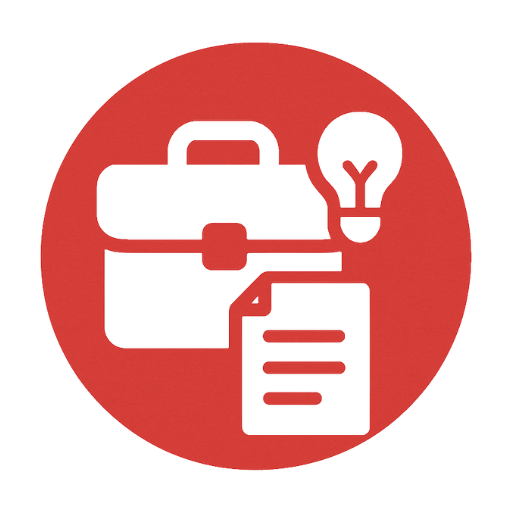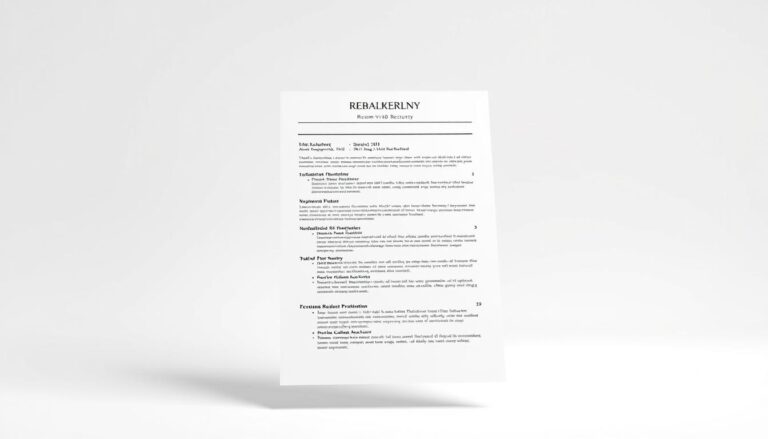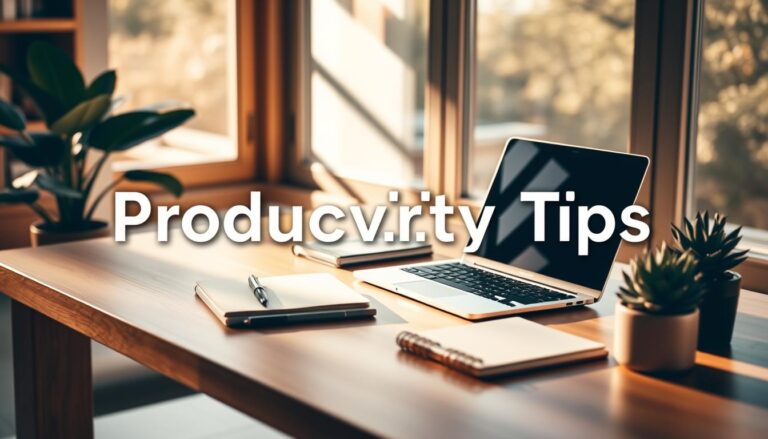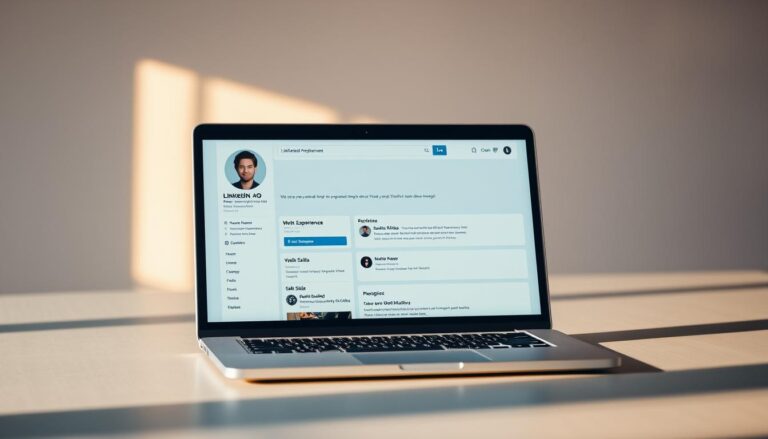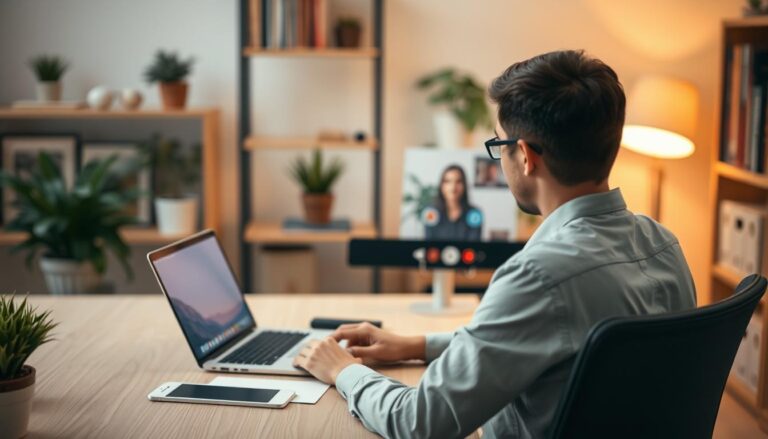Best Follow-Up Email Templates After an Interview
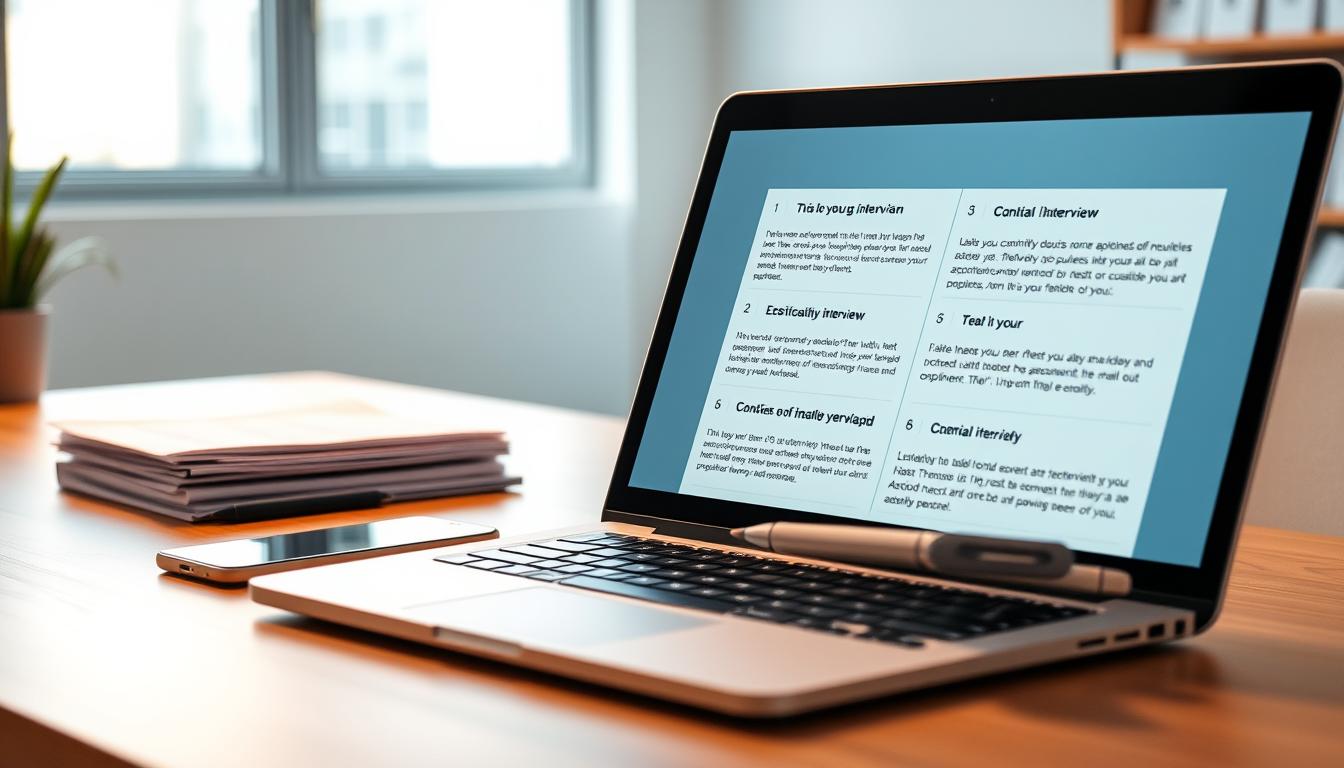
Writing the right follow-up email after a job interview is key to making a strong impression. Studies show that a well-written email can boost your chances of getting the job.
A good email shows you’re still interested in the job and are professional. It’s a chance to say thank you, show you’re still excited about the role, and share more details that might have been missed.
Using effective templates can make your follow-up emails stand out. This is especially important in a competitive job market.
Why Follow-Up Emails Are Crucial After an Interview
A well-crafted follow-up email can make a big difference. It can be the deciding factor between you and another candidate. Research shows that 80% of recruiters appreciate receiving follow-up emails. This shows they are proactive and interested.
Sending a follow-up email after an interview is more than just a courtesy. It’s a key step in the hiring process. It shows a candidate’s professionalism and their excitement for the job.
A thank-you email can also help clear up any doubts about the interview. It lets the candidate clarify their answers or address any questions. This approach can make a strong impression on the recruiter.
By understanding the importance of follow-up emails and using them in your interview strategy, you can improve your chances of getting hired.
The Perfect Timing: When to Send Your Follow-Up Email
The timing of your follow-up email is key to getting hired. It’s important to stay in the recruiter’s mind. This keeps you fresh.
It’s best to send a follow-up email within 24-48 hours after the interview. This shows you’re really interested in the job. It keeps the conversation going.
Waiting too long might make you forgettable. But sending it too soon could seem too pushy. The 24-48 hour window is the sweet spot.
By sending your email in this time frame, you show you’re professional and eager. It’s also smart to say you’re still interested in the job. And thank the interviewer for their time.
In short, timing is everything with follow-up emails. Send it within 24-48 hours after the interview. This will help you leave a good impression.
Key Elements of an Effective Follow-Up Email
An effective follow-up email is more than just a thank you note. It shows your interest and professionalism. Your email should have several key elements to make a lasting impression on the interviewer.
The first important element is a clear subject line. It should be short and directly related to the interview. A simple “Thank you for the opportunity to interview” works well.
A professional greeting is also crucial. If you can, address the interviewer by name for a personal touch. The email body should be concise and informative. It should reiterate your interest in the position and any extra information not covered in the interview.
Lastly, your email should end with an appropriate sign-off. Use something like “Best regards” or “Sincerely,” followed by your full name and contact info. This makes it easy for the interviewer to get back in touch with you.
By including these key elements, you can create a follow-up email. It not only thanks the interviewer but also strengthens your case for the job.
Best Follow-Up Email Templates After an Interview
A follow-up email after an interview is more than just a formality. It’s a chance to show your interest in the job, thank the interviewer, and make a lasting impression. Finding the right words can be tough, but with good templates, it’s easier.
We’ll share effective follow-up email templates for all experience levels. Whether you’re new to the job market or have years of experience, we’ve got you covered.
For Entry-Level Positions
For entry-level jobs, your email should show your eagerness to learn. Here’s a template to help:
Subject: Thank you for the opportunity
Dear [Interviewer’s Name],
I’m truly grateful for the chance to interview for the [Position] role at [Company Name] on [Interview Date]. I loved learning about the job and how it fits my skills and interests.
Talking with you made me even more excited about joining [Company Name]. I’m looking forward to being part of your team and learning from others.
Thank you again for your time and consideration. I’m eager to talk more about my application.
For senior roles, your email should focus on your experience and how you can add value. Here’s a template:
Subject: Appreciation for the Interview Opportunity
Dear [Interviewer’s Name],
I want to thank you for letting me interview for the [Position] at [Company Name]. Our talk on [Interview Date] showed how my skills match your company’s goals.
I’m sure my experience and achievements can help [Company Name]. I’m ready to contribute to your team’s success and explore how we can achieve great things together.
Thank you for your time, and I look forward to the next steps.
Best regards,
[Your Name]
It’s important to tailor these templates to your own voice and the job you’re applying for. Emphasize what makes you unique and relevant.
By using these templates, you can write a strong follow-up email. It will help you stand out and leave a good impression on the interviewer.
Customizing Templates for Different Interview Scenarios
Creating a successful follow-up email means tailoring it for each interview type. Whether it’s a phone or video interview, you need to show you’re a good fit for the job. This shows your adaptability and interest in the position.
After a phone interview, your email should mention specific topics you discussed. Highlight your skills and how they match the job. This personal touch can make your email stand out and leave a positive impression.
For a video interview, you might talk about the virtual setting. Mention how you appreciated the interviewer’s flexibility in doing a remote interview. This shows you can adapt to new situations.
When making your follow-up email templates, think about the interview’s tone. If it was formal, keep your email professional. If it was more casual, you can relax a bit while still being professional.
By customizing your follow-up email for each interview, you show you pay attention to details and are excited about the role. This can really help you make a strong impression on the interviewer.
Industry-Specific Follow-Up Email Strategies
Industry-specific follow-up email strategies can really help you get a response. Each industry has its own norms and ways of communicating. This affects how well your follow-up emails work.
In tech, emails are quick and to the point. This matches the fast and innovative tech world. When you’re applying for tech jobs, show off your tech skills and love for new tech trends.
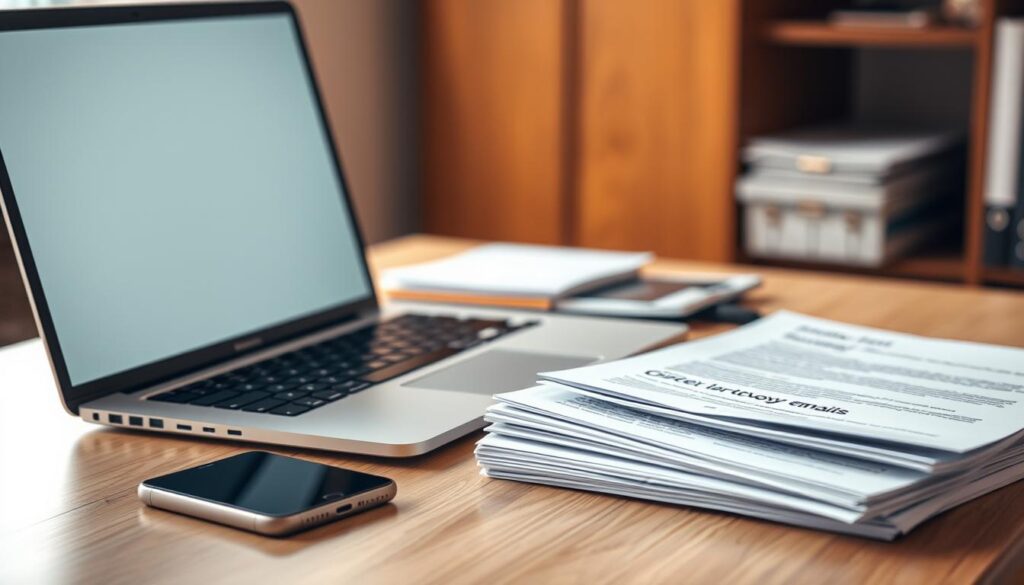
Healthcare and finance need more formal emails. These emails should show you really get the industry’s challenges and rules. Adjusting your email strategy for the industry you’re applying to can really help.
Creative fields like graphic design or writing let you show your style. But, keep it professional and make sure your email is clear and error-free.
Knowing your industry well and tailoring your emails can help you stand out. This way, you’re more likely to get a response.
Common Mistakes to Avoid in Your Follow-Up Emails
Following up after an interview is delicate. Here are common mistakes to avoid. A well-crafted follow-up email can make a great impression. But, some mistakes can hurt your job chances.
Being too pushy is a big mistake. It’s good to show you’re excited about the job. But, being too aggressive can turn off the interviewer. Keep your tone polite and professional.
Not proofreading your email is another error. Typos and grammatical mistakes can give a bad impression. Make sure to check your email carefully before sending it.
Sending your follow-up too soon is also a mistake. Wait at least 24 hours after the interview. This lets the interviewer handle other tasks.
Avoiding these mistakes helps you make a good impression. You want to be seen as professional and enthusiastic. Not as pushy or careless.
How to Personalize Your Follow-Up Email
A personalized follow-up email shows you’re really interested in the job. It helps you connect with the interviewer. This can make you stand out more.
To make your follow-up email personal, start by talking about specific parts of the interview. Show that you were really listening and care about the job.
Key Tips for Personalization:
- Mention a topic or project discussed during the interview.
- Show appreciation for the interviewer’s time and insights.
- Reiterate your enthusiasm for the position and the company.
For example, you could say, “I appreciated your insights on [topic] during our conversation. It made me even more interested in the role and the company’s mission.”
Also, make your email fit the company culture and the interviewer’s style. This shows you’re flexible and ready to fit in.
By using these tips, you can make a follow-up email that really catches the interviewer’s eye. And it will leave a good impression.
What to Do If You Don’t Hear Back
When you don’t get a reply after your follow-up email, it’s crucial to think carefully about what to do next. Not getting a response can be frustrating, but it doesn’t always mean you’ve been turned down.
Assess the Situation: Before you decide what to do next, check how long it’s been since you sent your follow-up email. The hiring process can take a while, so it’s important to be patient.
If enough time has passed, you have a few options. You could send a second follow-up email if you think the hiring team should have made some progress by now. Or, you could try a phone call to ask about your application status. This shows you’re still interested in the job and might get a response.
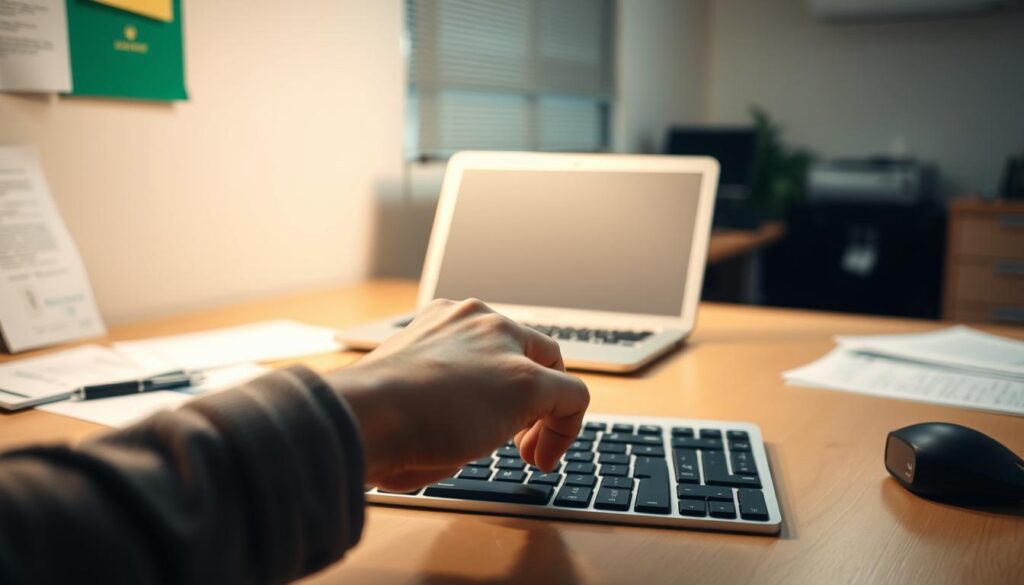
When you call, be ready to leave a voicemail if no one answers. Keep your message short and professional. Say you’re still interested in the job and ask for an update on your application.
Remember, persistence is key, but knowing when to move on is also important. If you still don’t get a response after trying these steps, it might be time to look for other job opportunities.
Conclusion
Writing a good follow-up email after an interview is key to making a strong impression. This article shows how important follow-up emails are in the hiring process.
Good follow-up emails show you’re really interested in the job. They keep you on the interviewer’s mind. Using the tips and examples from this article can help you stand out.
In short, sending follow-up emails is a smart move. It shows you’re professional and serious about the job. By doing this, you’re taking a proactive step towards getting the job you want.
